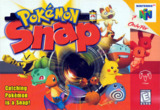Photography simulation might not sound very exciting, but that shouldn’t prevent you from enjoying Pokemon Snap.
You traverse various environments in the Zero-One buggy, the vehicle that will get you around Pokemon Island. The path you take in each level is linear, and you’ll find it progresses similarly to an on-rails shooter. As you chug along, you’ll have ample opportunity to snap the Pokemon that inhabit the course you’re on. Holding the Z-button focuses the camera, allowing you to take a shot. Each photo is graded at the end of the course, so it’s important to get some good snaps. Centring the target is the main way to score more points, but you can score bonuses depending on the target’s pose and size (or how close you were when you took the photo). Your camera alone won’t be enough if you want to become a master photographer. As you fill up the report, Professor Oak (who sent you on this mission) will reward you with some cool tools to make your job easier. The bait tool, for example, allows you to throw down food that will lure Pokemon, and the speed modification to the Zero-One allows you to catch up with fast-moving Pokemon. They’re easy to use, and you have to use them well to get pictures of certain Pokemon.
Considering there are now four generations of Pokemon games (and close to five-hundred monsters), the amount of creatures you can snap can seem a little low. Given the time of it’s release, Snap only has first-generation monsters to photograph, and even then, roughly half of them are in the game. This is the main problem; a short life-span. A couple of extra courses would have been nice to lengthen the game, and it would have been a good excuse to add in some more Pokemon.
It looked pretty good for 1999, and surprisingly, it isn’t so bad in 2007 either. Technically, it is blown away by everything that has been released since then, but the Pokemon are instantly recognisable and the environments (despite there being only seven courses) are refreshingly varied. Each course has it’s own unique theme, such as volcano, river, and cave (you’ll even get to space if you’re good enough), which succeed artistically, despite the technological inferiority it is plagued with compared to today’s games. Aurally, Snap is underwhelming. The background tracks are passive and forgettable, adding nothing to the game. The “voice-acting” of the Pokemon is a bit better, adding some life to the environments, but it doesn’t save Snap’s poor sound package.
Pokemon Snap is worth checking out because, even eight years after it’s release, there is still nothing quite like it. It’s longevity is hurt by a lack of challenge and multi-player, but the photography aspect is implemented very well. So well, in fact, that you’ll probably want to snap ‘em all and get high scores for each photo. Pokemon fans that missed it in 1999 aren’t too late; there is still fun to be had. For non-Pokemon fans, if you think you could enjoy some light-hearted photography, there’s no harm in checking it out.

